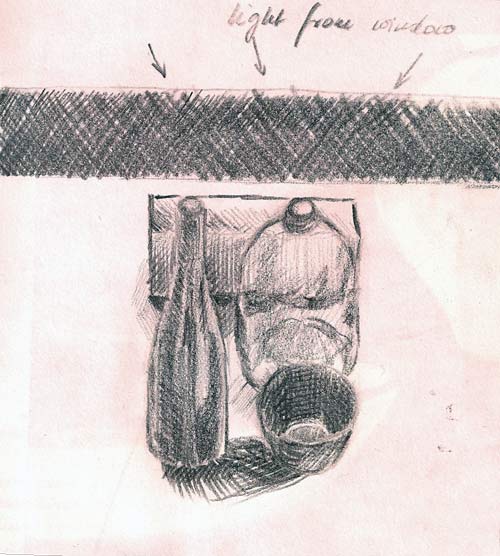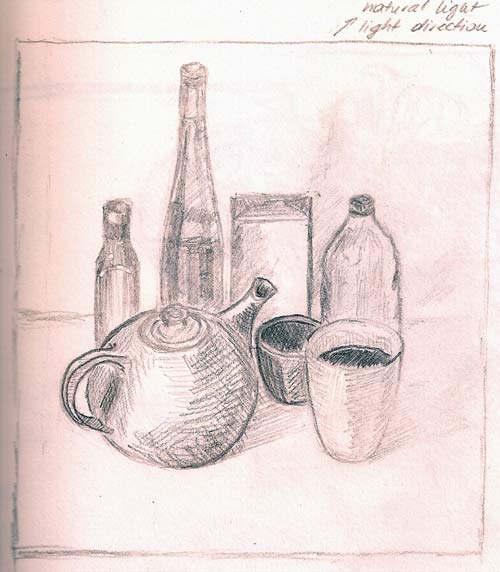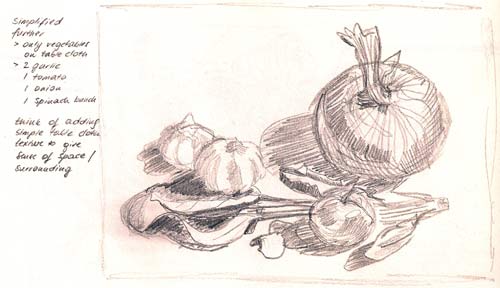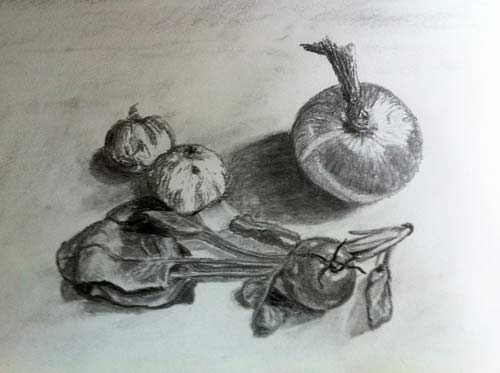Project: Still life
March 22, 2011 1 Comment
After the Morandi-encounter I felt quite inspired. Reading about Morandi and his messy studio and then looking at his effortlessly orderly looking still lives struck a chord with my nature I guess. It was an effort for him to create order (see the note that it sometimes took him ages to set up the vessels/bottles/jars), it didn’t come easily.
I wanted to create orderly still lives of made objects and experimented with visual unity and simplifying. And I discovered the beauty of combining 2 kinds of pencils (see above – the last sketch of this exercise). So much better than my normal smudge (compare the first drawing below done only with a soft pencil) …
The key to Morandi might be that his objects are unified – forming very simple compositions like squares etc – but – as I tried to arrange perfect squares with my objects I realised Morandi’s objects were NOT arranged to form a “clean” bigger shape like a square. Instead the objects that appear symmetrically arranged are just a tiny bit off – but that adds a lot of life to his still lives.
Then I proceeded to the composition of natural objects and had obviously forgotten all about order and limitation and HB pencils. So I first started some rather messy compositions in a soft pencil, they might have been recognizable in colour (as onions, tomatoes, spinach, garlic and sugar snaps) – but in terms of composition (which should work in black or white as well) it turned out a total jumble. Nothing stands out on that plate. No structure.
So I slowly took things off the plate (there was too much on my plate literally), then I took the plate itself out and then also the indicated table (taped off) and ended up with a much more simple and clean composition (see below). Adieu sugar snaps.
Check and log
Do you think it it easier to suggest 3D on man-made or natural objects (explain)?
For me the natural objects were harder. A bottle is recognisable as a bottle even if I do not draw that wobble that this particular bottle has. But vegetables – I had the sensation – lived of their texture, their fine lines, their bulges here and there – that’s not a simple shape. A garlic is much more complicated than an onion. But the onion, which is similar in it’s shape simplicity to the tomato, looks different from a tomato – and that’s not just the size – but also the whole texture. The dry and brittle onion skin versus the smooth tomato.
How did you create a sense of solidity in your composition?
I tried to create varied surfaces – even if the side of the object was flat. Also the shadows and cast lights and shadows suggested volume (example tomato, onion in last exercise). The man-made objects in my first sketches didn’t have much cast shadow as I was working outside on the balcony and the day was overcast. But inside it was so dark I couldn’t see a thing.
Do you think, changing the arrangement of your composition make a s difference to your approach and the way you create a sense of form?
I tried to give each object their due in their own right but also to create a flow or a “togetherness” of the objects. I wanted to bear in mind Morandi’s hard-won sense of order so simplifying the initial arrangement was key. All first sketches were really not very good and I needed at least 2 simplification steps t get to something better. This saying, that you should finish something and in the end take something away to make it perfect is true for me.
How did you decide how to position yourself in relation to the objects?
Our flat doesn’t have much light so I am constantly looking for a good spot to draw, where the shadows are strong enough to create more contrast. So I found myself squeezing between shelves and tables to get that light spot. I like views where you can see the objects slightly from above. I thought that if – say the onion – is pretty obscured by other objects then maybe I should take it out entirely.
Maybe my ex-colleague C-gal was right claiming my famous last sentences would include: “What is the purpose of these ornaments? What purpose exactly do they serve in life? And what do people do with these random photographs they take in the train station? Its just random.”
To summarise – I tried to position myself so that I have enough light and see each of the objects well and they would still form an interesting unity.







Pingback: Tutor Assessment of Assignment I from Drawing I: A lot of theory, too little practice « carpetmoss